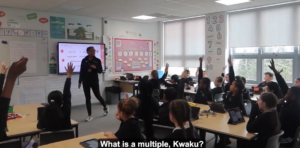05.16.24How Charlotte Pottinger Uses Retrieval Practice and Top Flight Means of Participation to Start Class

Maths with Ms. Pottinger: Everybody is all-in!
In this post, I’m going to share a video of Charlotte Pottinger’s classroom at Rivers Primary Academy in Walsall. I’ve been looking forward to sharing it because it’s so lovely on so many levels.
I’m going to call it a Retrieval Practice clip because that’s her main purpose–to start her Maths lesson by making sure students build their long-term memory of key terms and ideas. But there’s so much else to appreciate here… especially Charlotte’s brilliant Means of Participation–her clarity with students about how they should answer each question, her intentionality about which Means of Participation she uses, the degree to which she’s made each of those a well-installed routine, and how familiarity with those routines allows Charlotte’s students to participate with energy, verve and confidence.
Here’s the clip:
Some notes:
Charlotte starts class with her first question right away. “Ok, let’s refresh our memories and go through some of our key star words,” she says, cueing her students that they will be doing Retrieval Practice. Then she adds: “Talk to your partner. What is a multiple?”
Notice that she signals to them deliberately before she asks the question how she’ll want them to answer it. Adam Boxer calls this frontloading. A well-oiled routine clearly signaled. Result: the room crackles to life, creating a Norm Signal… every student in the room showing all the other students how engaged and eager they are to be involved. “Norms are the unwritten rules that govern the behaviour and attitudes of a group(such as a society or school). They are so powerful that they tend to override more formal rules or policies,” Peps McCrea has written. You can see here how early magnification of the norm of engaged positive participation cascades through Charlotte’s class.
At :23 you can see the response. Every hand eagerly in the air! If Charlotte has one challenge in this clip, it’s that her pupils are all so eager to raise their hands that Cold Calling might be tricky.
I also love her Turn and Talk at :51. Keaton has identified that an integer is a positive or negative [whole] number. Charlotte asks: “What does he mean by positive? If he’s talking about a positive number, he means what? [Pause] Tell you partner.”
She might have said, “If I am talking about a positive number what do I mean?” but her phrasing gives Keaton a lovely bit of credit for his previous answer. The slight pause before the Turn and Talk gives students enough wait time to think of the answer so that when she cues the Turn and Talk, the room again practically explodes.
But then cleverly she keeps her Turn and Talk very short! She’s getting data that students likely know the answer. The purpose is to get them to rehearse it. But it’s a short answer. Once they’ve done that, the purpose of the Turn and Talk has been achieved. If she let it go too long students would have talked it out already and would have less energy for answering in the whole group after. A Turn and Talk that is a little too short is better than one that is a little too long. It causes students to practice always being fully engaged during Turn and Talks. And it keeps the class pace-y and engaging. That feeling makes students feel happy and motivated at the start of class.
The class is off to a flying start but at 1:10 Charlotte slows it down slightly, switching her Means of Participation from Turn and Talk to Everybody Writes. Being able to define a fraction takes a little more thought. And it’s really important to the upcoming lesson. Asking students to write it 1) ensures that everyone gets the benefit of the retrieval–they all have to answer the question–and 2) causes a bit more desirable difficulty. That is, student work a little harder to get the definition into writing and this will cause them to remember it better.
Note again how well-oiled the routine of brief episodes of formative writing is. Her name for it–Silent Solo–reminds them of the familiar expectations for how to complete the task.
One more benefit of writing: Charlotte circulates and quickly spots a few students whose answers need elaboration or clarity. You can see her doing this at 1:38 in the video.
Freddie’s answer is lovely… and almost right. But Charlotte has prepared by writing down exactly what answer she hopes she’ll get–it’s on her clipboard!–and so she quickly spots that, as she puts it, Freddie has the right words in the wrong order. Instead of “rounding up” and telling Freddie what the answer might have been, she goes back to him to let him improve the answer himself. This is called “Right is Right” and among other things it lets Freddie feel fully successful.
As the clip ends you can see Charlotte is beginning to transition from Retrieval Practice to a new activity–they are starting to learn about hundreds–but the energetic positive norms she set while causing every student to review key concepts has carried over into the heart of her lesson.
Maybe that’s the biggest takeaway: how happy and fully engaged the students as a result of her careful planning and strong routines. They are all-in for learning.
